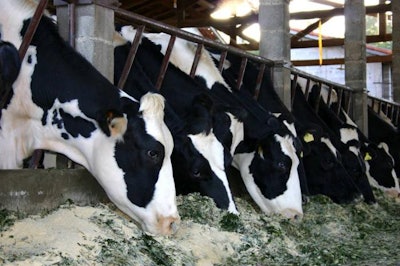
Ruminants, which include dairy cows — the object of this discussion — are designed to live on green roughage that they graze on throughout the day. At least, that’s the theory. Now, enter commercial practice and genetic selection and we have an animal that produces more milk than she planned on producing for her calf. Today, on average, dairy cows will produce about 10,000 kg of milk in one lactation period, or just above 30 kg milk daily on average, with peaks up to 50 percent higher.
Now, for a cow to consume enough forage to produce such quantities of milk is something she is not prepared for as her stomach capacity has not expanded at the same genetic rate as her milk yield potential. Thus, we must use concentrated feeds to provide enough energy (and protein, calcium, phosphorus, vitamins and trace minerals). Energy comes in the form of cereals, but too much of that creates its own problems; namely acidosis and a drop in milk fat concentration.
Meeting energy demands
In high-yield cows, meeting their daily energy demands is indeed problematic. On one hand, they must consume enough forage for their rumen to function properly. In addition, they can consume so much of a cereal concentrate supplement before acidosis becomes a problem. Then, adding fats or oils appears as a viable solution, especially as they are super-concentrated sources of energy. The only problem (again) is that cows are not prepared, from a rumen physiology point of view, to handle fats and oils — at least in quantities that offer substantial coverage of their needs for high milk production. It all goes back to ruminants designed to live on roughage.
The problem with lipids is focused on unsaturated oils, and it is two-fold. First, unsaturated lipids can be toxic to fiber digesting bacteria. Second, they tend to cover fiber particles, limiting thus access to fiber digesting bacteria. The combination of both affects negatively overall fiber digestibility, leading to reduced rumen pH and thus, acidosis. It would be best if any and all fats and oils were excluded from dairy cow diets, but this is impractical. Thus, a three-step is followed as recommended by the leading dairy nutritionist Dr. M. Hutjens of the University of Illinois.
- Each cow should receive daily no more than half a kilogram (Hutjens says one pound, but we need to round it up for the rest of the world) oil from whole seeds such as cottonseeds, soybeans, rapeseed, etc. Whole seeds are preferred to ground up ones as the oil is gradually released during rumination. Using pure oils is not recommended. Cottonseeds with linters offer the advantage of extra fiber, whereas soybeans are a good source of protein.
- An additional quarter kilogram of saturated fats (like grease and tallow) can be added to the above quantity of oil, and this only because saturated fats tend to be more expensive. If the opposite is true, up to three quarters of a kilogram of saturated fats alone can be fed. It is highly unlikely for a small(er) dairy farm to be able to handle saturated fats, as these require special equipment to keep them fluid, especially during cold times.
- There are commercial sources of inert fats (highly saturated) that can be used without fear of affecting rumen pH. Such fats are hydrogenated lipids, calcium soaps and encapsulated forms. The only real negative is their high price, but they usually offer good value for money when high-yielding cows are concerned. Plus, they are in a dry convenient form, and they can be fed up to half a kilogram per cow per day, in addition to the above.
Thus, if we were to maximize lipid intake in a high-yielding dairy cow, we could add 500 grams of oil through an oilseed, 250 grams from tallow and 500 grams from an inert source. Assuming they all confer about the same amount of energy (for simplification of our discussion), we can provide 1.25 kg x 5.83 Mcal/Kg Net Energy = 7.3 Mcal NE for lactation, which is enough for about 10 kg extra milk (actual numbers will vary, of course, depending on milk fat percentage).
Avoiding problems
Ketosis is a metabolic disorder caused by an excess concentration of ketones in blood circulation. Ketones are by-products of fat catabolism (burning fat for energy), something that happens in fresh cows. These animals suffer from a catastrophic combination of reduced appetite and increased energy needs. This leads to body fat mobilization, which ends up in ketone production. The problem can be as severe, as is severe the drop in post-partum feed intake. To avoid compounding the ketosis problem, many nutritionists recommend avoiding supplemental fats and oils in fresh cow diets — which will be "burned" to produce energy as the cow is in negative energy balance and keeps "melting" body fat. Instead, the emphasis is on increasing total dry matter intake.
In brief, dairy cows and supplemental fats and oils don’t make a good match. Nevertheless, for all practical purposes, when we must feed high-yield cows, we need to use some form of lipids. A combination of different sources appears optimal as far as keeping cost down. However, using an expensive but inert fat source is preferable from ending up with a number of otherwise avoidable problems.

















